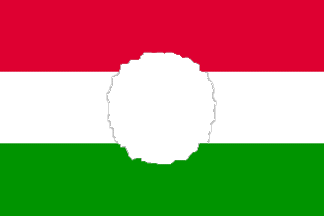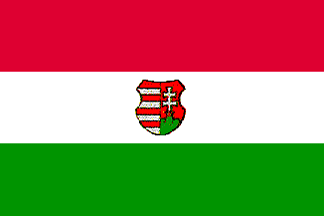 zachary harden
zachary harden
Keywords: hungary | hole |
Links: FOTW homepage | search | disclaimer and copyright | write us | mirrors

Last modified: 2023-06-03 by  zachary harden
zachary harden
Keywords: hungary | hole |
Links: FOTW homepage |
search |
disclaimer and copyright |
write us |
mirrors


image by Sándor Kiss, 3 September 1998
See also:
During the Hungarian uprising against the communist
authorities in 1956, the communist arms were removed from the
center of their flag, leaving a hole. The
Hungarian-flag-with-hole is still used by the Association of
Political Prisoners (translation approximate, but essentially
those Hungarians imprisoned after the uprising - the organization
now commands some considerable influence in Hungary). The
newspaper of the association is (or maybe was, as my info. is
some years old) 'The Hole'. I used to have a metal lapel pin of
the Hungarian flag, complete with hole, given to me by a friend
who was a member. The hole was bigger than just the white stripe,
since the arms also stretched into the red and green fields.
Stuart A. Notholt, 3 November 1996
The flag at <mkdsz.hungary.cc>
has been given to the European Council on the 23rd of June 1999.
This is an original flag. This flag has got the "Arms of the
Revolution" since 24th of October 1956. Till 1989 the flag
was in the USA to represent the Hungarian Freedom. On 16th of
June 1989 the flag was a participant in the reburial ceremony of
Imre Nagy, the Prime Minister in the days of the Revolution and
Independence War. He was executed on the 16th June 1958.
István Molnár, 1 November 2000
At our church, St. Stephen of Hungary (Burlington, Ontario,
Canada), we also have an authentic 1956 Hungarian flag, with the
crest cut out, of course. I am unsure of this particular
flag's history, but I could look into it, if you like. It
is displayed three times a year: 1) On the Friday nearest October
23rd, when our scout troop takes it out to a nearby cemetary
where we had a monument raised in rememberance of the Revolution,
where we have a ceremony (often in the rain, for some reason),
involving revolutionary poems, prayers, patriotic songs, and
firsthand accounts by people who fought in the Revolution.
2) On the Sunday following said date, when it, the Canadian flag,
and the boys' and girls' scout troops (not girl guides or
whatnot) flags are displayed for a "zászlós mise", a
"flags' mass". And, lastly, 3) At the luncheon
following said mass, when it is paraded before local dignitaries,
often including the mayor and the Hungarian Consul from Toronto.
Georges Kovari, 2 November 2000
It should perhaps be pointed out that this flag ceased to be
an exclusively historic flag. In recent years, it has very much
become a political flag, specifically a symbol of opposition to
Hungary's current administration.
Thorsten, 23 October 2003
There is a photo at Élet
és Tudomány (22 October 2004), of a tricolour with the
Kossuth Coat of Arms in October 1956 at the demolished Stalin
Statue. The Kossuth Coat of Arms (Coat of Arms without crown) has
been used by the people at the revolutionary era: 1849, 1918,
1948, 1956, 1989.
István Molnár, 21 October 2004
During May of 2004, there was a flag with a hole flying
outside the Hungarian Parliament building in Budapest. Here is my
photograph: <colindobson.co.uk>
where it can be seen that the hole occupies the white band of the
flag only and does not extend beyond that. The flag is on its own
flag pole in the grassed area, away from the building, with a
metal barrier around it.
Colin Dobson, 21 March 2006
The exhibit at the Hungarain Museum in Cleveland included
plenty of pictures, items and flags, including the one flying
over parlament during the 1956 events.
Milan Jovanovich, 22 October 2006

image by István Molnár, 6 November 2001

image by István Molnár, 19 October 2006
A national flag with hole and in the centre of the hole there
is the Kossuth Coat of Arms in Kossuth Square (at the Parliament)
can be seen at <www.youtube.com>.
This flag is one of the 56 flags of rememberence made in
2005-2006 by Mária Wittner, hero of 1956, seen in a photo in process of making
the flags. Peoples who had got one of these flags: Gergely
Pongrátz (1956 hero) Lech Walesa (Poland) etc...
István Molnár, 19 October 2006
The Hungarian flag with hole has appeared these days in the
demonstrations against the government. See photos at <news.bbc.co.uk>.
Francisco Gregoric, 24 October 2006
Is there a difference between a historical holey flag and a
modern holey flag?
Yes and no. When I have heard the term "flag of 1956"
('56-os zászló') in conversation, it tends to have one, clear,
undisputed meaning: A flag, now with a hole stretching
into the red and green bands of the tricolour, which is treated
with utmost respect, displayed annually in ceremonies and affairs
dealing with the revolution, and has been in the possession of
the community since that time. It seems to me that
every Hungarian community which I know of and come into contact
with has one of these; the flag itself is the symbol of the
community, its origins (as refugees of the revolution), its
survival. It is at the same time the "tomb of the
unknown freedom-fighter", a monument to those alive and dead
who were there, a visual and permanent reminder that we were
defeated, but not destroyed. So, a "flag of
56" in its only sense which I am familiar with, is this
respectful, ceremonial and solemn sense.
What about any red-white-green flag with a whole in the middle?
A flag of red-white-green with a hole in it at its most
basic; the symbol of a nation with its heart cut out; or, a
nation that has removed "those at the middle of it
all": a government considered unfair, treacherous,
undesirable, etc. The perception, of course, depends
on the perceiver.
What is the intention? Here, it is perhaps easier to
see. In all cases, with the exception of the
'sacrosanct' flags of '56 mentionned above, a modern and
historical holey flag are the same. They are symbols
of protest; of the nation, the community, the people taking to
the streets to protest a government it does not agree with, a
refusal of the status quo. And it is in this spirit which they
have been used. Perhaps here is where famed Canadian thinker
Marshall McLuhan's most well-known quote
fits: "The medium is the
message". The medium: a flag with a hole in its
centre, cutting out a symbol (perhaps Soviet, perhaps modern,
perhaps blank - noone but the person who cut the hole knows); the
message: "We Protest!"
And thus, I conclude, that the flags of 1956 and today with holes
in them are, and yet, are not
the same thing. The flags are identical. It
is their use which implies their difference.
Georges Kovari, 27 October 2006